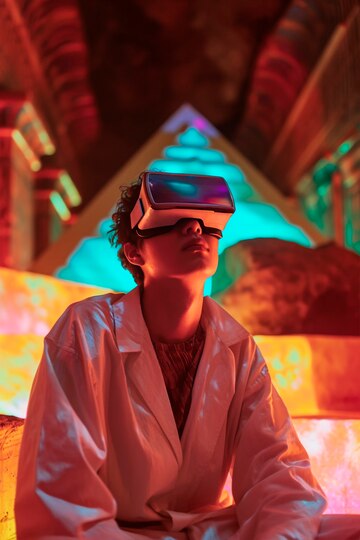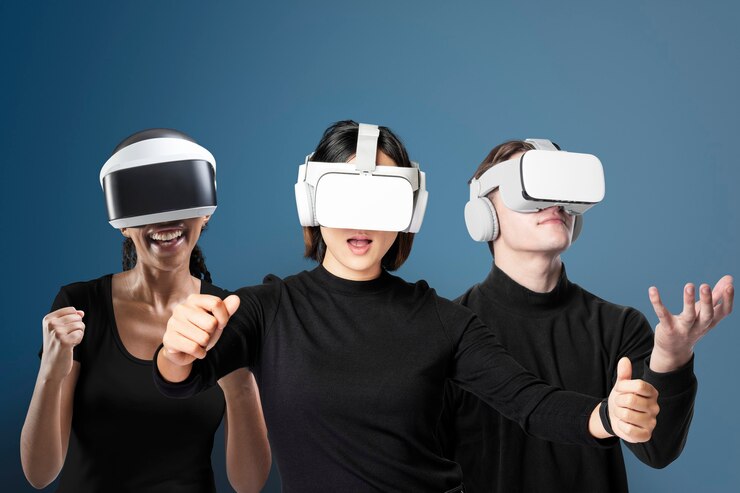Virtual Reality (VR) and Augmented Reality (AR) are transforming the way we interact with the digital world. What once seemed like futuristic concepts are now becoming part of our daily lives, revolutionizing industries from gaming and entertainment to healthcare and education. As technology continues to evolve, the future of VR and AR promises even more exciting advancements.
Understanding VR & AR
Virtual Reality (VR): Creates a completely immersive digital environment, replacing the real world with a computer-generated one. Users typically wear headsets like the Meta Quest, HTC Vive, or PlayStation VR to experience virtual worlds.
Augmented Reality (AR): Enhances the real world by overlaying digital elements onto it. Unlike VR, AR does not replace reality but adds digital objects to it. Examples include smartphone-based AR apps, smart glasses, and AR-powered navigation systems.
The Future of VR/AR: Key Trends & Innovations
1. The Rise of the Metaverse
The concept of a metaverse—a shared virtual world where people can socialize, work, and play—is gaining momentum. Companies like Meta (formerly Facebook), Microsoft, and Apple are investing heavily in VR/AR-driven metaverse experiences. In the future, we may see fully immersive digital worlds where users can attend virtual meetings, explore digital cities, and even shop in AR-powered stores.
2. Next-Gen Gaming & Entertainment
Gaming has been one of the biggest drivers of VR adoption, with titles like Half-Life: Alyx and Beat Saber showcasing the technology’s potential. In the future, we can expect even more realistic VR experiences, with improved motion tracking, haptic feedback suits, and AI-driven interactions that make virtual worlds feel more lifelike.
AR is also enhancing entertainment—think of Pokémon GO and interactive AR concerts where digital elements blend seamlessly with reality. As AR glasses become more widespread, immersive storytelling and interactive experiences will become the norm.
🏥 3. VR/AR in Healthcare & Therapy
VR and AR are already being used for medical training, allowing students to practice surgeries in virtual environments. In therapy, VR is helping patients overcome phobias, PTSD, and anxiety by exposing them to controlled virtual scenarios. AR is aiding doctors in visualizing complex medical procedures before performing them. As AI integrates with AR/VR, expect more personalized and effective healthcare applications.
🏫 4. Education & Training Revolution
Imagine a history lesson where students can step into Ancient Rome through VR or a chemistry class where AR displays interactive molecular structures. VR and AR are making learning more engaging and hands-on, helping students grasp complex subjects in new ways.
Beyond classrooms, industries like aviation, military, and engineering are using VR simulations to train professionals without real-world risks. This trend is set to expand, making training safer, more effective, and cost-efficient.
🛍️ 5. Retail & Shopping in AR
Retailers are embracing AR-powered shopping experiences, where customers can try on clothes virtually, preview furniture in their homes before buying, or see product details through AR-enhanced smartphone apps. Brands like IKEA, Nike, and Sephora are already leveraging AR, and with advancements in smart glasses, we may soon see an entirely new way of shopping.
🏗️ 6. Architecture & Real Estate
Imagine walking through a house before it’s even built! VR is allowing architects and real estate agents to create virtual property tours, helping clients visualize designs before construction begins. AR is also being used on construction sites, overlaying digital blueprints onto real-world structures, making planning and execution more precise.
📱 7. AR Glasses: The Future of Mobile Devices
As smartphone-based AR becomes more common, the next big leap will be AR glasses. Companies like Apple, Google, and Meta are developing sleek AR-powered glasses that could replace smartphones, offering a hands-free digital experience where notifications, navigation, and information are seamlessly integrated into the real world.
🚗 8. AR in Navigation & Automotive
AR is making its way into cars, with heads-up displays (HUDs) that project navigation instructions directly onto the windshield. This makes driving safer by allowing drivers to keep their eyes on the road while receiving real-time information. In the future, we may see fully AR-driven interfaces that enhance road awareness and even provide real-time hazard detection.
Challenges & Considerations
While the future of VR/AR is promising, there are challenges to address:
- Hardware Limitations: VR headsets and AR glasses need to become lighter, more affordable, and more powerful to ensure mass adoption.
- Privacy Concerns: AR collects real-world data, raising privacy issues regarding personal and environmental information.
- Motion Sickness: Some users experience discomfort in VR, and developers need to create more intuitive and comfortable experiences.
- Digital Overload: As VR and AR integrate more into daily life, finding a balance between the real and virtual worlds will be essential.
Final Thoughts: A New Digital Era is Coming
The future of VR and AR is shaping up to be more immersive, interactive, and accessible than ever before. As technology advances, we will see a shift from screen-based interactions to fully immersive digital experiences that blur the lines between reality and the virtual world.
Whether in gaming, healthcare, education, or business, VR and AR are set to redefine how we work, learn, and connect. Are you ready for the next digital revolution



